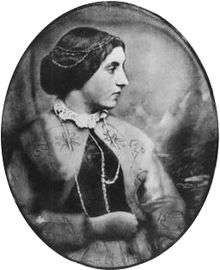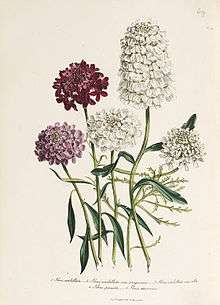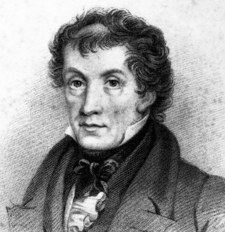Jane C. Loudon
Jane Wells Webb Loudon (19 August 1807 – 13 July 1858) was an English author and early pioneer of science fiction. She wrote before the term was coined, and was discussed for a century as a writer of Gothic fiction, fantasy or horror. She also created the first popular gardening manuals, as opposed to specialist horticultural works, reframing the art of gardening as fit for young women. Furthermore, she contributed to the work of her husband, John Claudius Loudon.
Jane Wells Webb Loudon | |
|---|---|
 | |
| Born | 19 August 1807 Birmingham, United Kingdom |
| Died | 13 July 1858 (aged 50) London, England |
| Occupation | Author |
| Nationality | British |
| Genre |
|
| Literary movement |
|
| Notable works |
|
| Spouse | John Claudius Loudon |

Early life
Jane Webb was born in 1807 to Thomas Webb, a wealthy manufacturer from Edgbaston, Birmingham and his wife. (Sources vary on her place of birth: according to the Oxford Dictionary of National Biography (ODNB), she was born at Ritwell House, which is possibly the same as Kitwell House at Bartley Green.) After the death of her mother in 1819, she travelled in Europe for a year with her father, learning several languages. On their return, his business faltered and his fortune was lost to excessive speculation. He sold the house in Edgbaston and moved to another of his properties, Kitwell House at Bartley Green, six miles away. He died penniless in 1824, when Jane Webb was only 17.[1][2][3]
The Mummy!
After her father's death, she found that "on the winding up of his affairs that it would be necessary to do something for my support. I had written a strange, wild novel, called the Mummy, in which I had laid the scene in the twenty-second century, and attempted to predict the state of improvement to which this country might possibly arrive.[4]
She may have drawn inspiration from the general fashion for anything Pharaonic, inspired by the French researches during the Napoleonic invasion of Egypt; the 1821 public unwrappings of Egyptian mummies in a theatre near Piccadilly, which she may have attended as a girl, and very likely, the 1818 novel by Mary Shelley, Frankenstein; or, The Modern Prometheus.[2] As Shelley had written of Frankenstein's creation, "A mummy again endued with animation could not be so hideous as that wretch," which may have triggered young Miss Webb's later concept. In any case, at many points she deals in greater clarity with elements from the earlier book: the loathing for the much-desired object, the immediate arrest for crime and attempt to lie one's way out of it, etc.[2] However, unlike the Frankenstein monster, the hideous revived Cheops is not shuffling around dealing out horror and death, but giving canny advice on politics and life to those who befriend him.[2] In some ways The Mummy! may be seen as her reaction to themes in Frankenstein: her mummy specifically says he is allowed life only by divine favour, rather than being indisputably vivified only by mortal science, and so on, as Hopkins' 2003 essay covers in detail.[2]
Unlike many early science fiction works (Shelley's The Last Man, and The Reign of King George VI, 1900–1925]], written anonymously in 1763),[5]) Loudon did not portray the future as her own day with mere political changes. She filled her world with foreseeable changes in technology, society, and even fashion. Her court ladies wear trousers and hair ornaments of controlled flame. Surgeons and lawyers may be steam-powered automatons. A kind of Internet is predicted in it. Besides trying to account for the revivification of the mummy in scientific terms – galvanic shock rather than incantations – "she embodied ideas of scientific progress and discovery, that now read like prophecies" to those later down the 1800s.[6] Her social attitudes have resulted in the book being ranked among proto-feminist novels.
The Mummy!: Or a Tale of the Twenty-Second Century was published anonymously in 1827 by Henry Colburn as a three-volume novel, as was usual in that day, so that each small volume could be carried around easily. It drew many favourable reviews, including one in 1829 in The Gardener's Magazine on the inventions it proposed.[n 1][7]
Marriage

Among other foreshadowings of things that were to be, was a steam plough, and this attracted the attention of Mr. John C. Loudon, whose numerous and valuable works on gardening, agriculture, etc., are so well known, led to an acquaintance, which terminated in a matrimonial connection.[6]
John Claudius Loudon wrote a favourable review of The Mummy in a journal he edited. Seeking out the author of the text, whom he presumed to be male, he eventually met Jane in 1830 and they married a year later.[8]
They had a daughter, Agnes Loudon (1832–1863 or 1864), who became an author of children's books. Their circle of friends included Charles Dickens and William Makepeace Thackeray.
In 1829, Loudon published the semi-fictional Stories of a Bride, her second and last foray in fiction. Instead, she shifted her focus to making gardening an acceptable hobby for young women.
Horticultural work
The Loudons were considered the leading horticulturalists of their day.
She had found the gardening manuals of the day inaccessible, as they were written for those already deeply into the field, rather than those seeking new information. Loudon noticed there were no entry-level manuals, for which she saw a need and potential interest. She set to writing them as she herself learned: Instructions in Gardening for Ladies; The Ladies' Flower Garden; The Ladies' Companion to the Flower Garden; Botany for Ladies; The Lady's Magazine of Gardening, etc. According to Adams, these became "standard books of reference, and attained a large circulation." She was not only influenced by her husband in gardening, but by John Lindley, whose lectures she attended; she ardently applied her studies and redirected her energy to making gardening an accessible pastime for women, who were often excluded from planting practices.
Later life
John Loudon died of lung cancer in 1843, leaving Jane to raise their 10-year-old daughter Agnes. While earning a living by writing, she received a "deservedly gained" pension of £100 a year from the Civil List.[6]
In late 1849 Loudon began editing The Ladies' Companion at Home and Abroad, a new magazine for women. Successful at first, its sales fell and she resigned. She died in 1858 at the age of 51.[9]
Legacy
.jpg)
In 2008 a blue plaque was erected in her honour, by Birmingham Civic Society, at Kitwell Primary School, near the site of Kitwell House.[10]
A plaque jointly commemorating Jane and John was erected at their former home, 3 Porchester Terrace, Bayswater in 1953, by London County Council.
Works
- The Mummy!: Or a Tale of the Twenty-Second Century (1827)[7]
- Stories of a Bride (1829)
- Young Ladies Book of Botany (1838)
- Gardening for Ladies (Second Edition, 1851) (1840)
- The Ladies' Flower-garden of Ornamental Bulbous Plants (1841)
- The first book of botany, 1841 (1841)
- Botany for Ladies (1842)
- The Ladies Magazine of Gardening (1842)
- The Ladies Companion to the Flower Garden (Seventh Edition, 1858) (four volumes, 1840–44)
- My Own Garden (1855)
Notes
- Not all critics seem to have read the book carefully. Adams (1865) also says she envisaged a steam-powered plough; Hopkins (2003) says it was a steam-powered milking machine. The on-line copy of The Mummy!: A Tale of the Twenty-second Century, Volume 1 at Google Books refers only to a steam powered digging-machine on page 71. See §Further reading.)
References
- "Profile of Jane Loudon", Oxford Dictionary of National Biography. (Oxforddnb.com), Retrieved on 5 April 2012.
- Lisa Hopkins, "Jane C. Loudon's The Mummy!: Mary Shelley Meets George Orwell, and They Go in a Balloon to Egypt", in Cardiff Corvey: Reading the Romantic Text, 10 (June 2003). Cf.ac.uk (25 January 2006). Retrieved on 5 April 2012.
- "Profile of Jane Loudon", Birmingham City Council
- Shigitatsu Antiquarian Books. Profile of Jane Webb Loudon (1807–1858). Shigitatsu.com. Retrieved on 5 April 2012.
- The reign of George VI. 1900–1925; a forecast written in the year 1763. [London] W. Niccoll, 1763, Published in 1899, Archive.org. Retrieved on 5 April 2012.
- Henry Gardiner Adams (1857). A Cyclopaedia of Female Biography; consisting of Sketches of all Women, who have been distinguished by great Talents, Strength of Character, Piety, Benevolence, or moral Virtue of any kind; forming a complete Record of Womanly Excellence or Ability: Edited by H. G. Adams. Groombridge. Retrieved 5 April 2012.
- Mrs. Loudon (Jane) (1828). The mummy!: A tale of the twenty-second century. H. Colburn. Retrieved 5 April 2012.
- Marilyn Bailey Ogilvie; Joy Dorothy Harvey (2000). The Biographical Dictionary of Women in Science: L-Z. Taylor & Francis. p. 806. ISBN 041592040X. Retrieved 25 February 2015.
- Chambers, S. J. (2012). "The Corpse of the Future:Jane C. Loudon's The Mummy! and Victorian Science Fiction". Clarkesworld Magazine. Retrieved 28 January 2019.
- "Kitwell". Bartley Green District History Group. Retrieved 3 August 2020.
Sources
- H.G. Adams, Cyclopaedia of Female Biography; consisting of Sketches of All Women who have been distinguished by Great Talents, Strength of Character, Piety, Benevolence, or Moral Virtue of any kind, forming a complete record of Womanly Excellence or Ability; London, 1865.
- Lisa Hopkins, "Jane C. Loudon's The Mummy!: Mary Shelley Meets George Orwell, and They Go in a Balloon to Egypt", Cardiff Corvey: Reading the Romantic Text 10 (June 2003). Online: Internet (date accessed): http://www.cf.ac.uk/encap/romtext/articles/cc10_n01.html.
- Oxford Dictionary of National Biography
- Internet Archive, The Mummy!: Or a Tale of the Twenty-Second Century (1827)
Further reading
- Bea Howe, Lady with Green Fingers: The Life of Jane Loudon (London: Country Life, 1961)
- Full text of "The Reign of George VI. 1900–1925; a forecast written in the year 1763". (republished)
- Internet Archive, The Mummy!: Or a Tale of the Twenty-Second Century (1827)
External links
| Wikimedia Commons has media related to Jane Loudon. |
| Wikisource has original text related to this article: |
| Library resources about Jane C. Loudon |
- Works by Jane C. Loudon at Project Gutenberg
- Works by or about Jane C. Loudon at Internet Archive
- Works by Jane C. Loudon at LibriVox (public domain audiobooks)

- "Mrs Loudon & the Victorian Garden". Prints & Books. Victoria and Albert Museum. Retrieved 3 April 2011.
- Jane Webb Loudon at the Internet Speculative Fiction Database
- Project Continua: Biography of Jane Loudon Project Continua is a web-based multimedia resource dedicated to the creation and preservation of women’s intellectual history from the earliest surviving evidence into the 21st century.